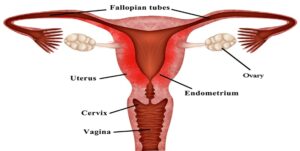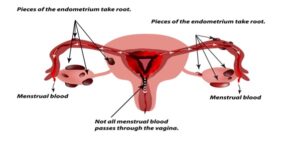WHAT IS ENDOMETRIOSIS?
Endometriosis is a condition where tissue similar to the uterine lining grows outside the uterus, and can cause pelvic pain, painful periods, heavy bleeding, and difficulty conceiving, but some individuals experience no symptoms at all. It can commence at puberty and continue through to menopause.

CAUSES OF ENDOMETRIOSIS.
Some factors are considered as possible causes of Endometriosis. They include:
- RETROGRADE MENSTRUATION: This is when some menstrual blood flows upwards and through the fallopian tubes instead of outwards through the cervix. Many women experience this at some point during their menstruating years. The body however usually gets rid of the abnormal flow of tissues. In some cases, the body is unable to resorb these tissues, leading to their being deposited on other tissues and organs thereby causing endometriosis.
- GENETICS: Endometriosis has been linked to genetic traits.
- ENVIRONMENT: Some toxic chemicals from environmental pollution are suspected to lead to this condition, but this is not proven
- LYMPHATIC SPREAD: It is suspected that lymphatic drainage carries some of these tissues causing extensive spread and deposits on other tissues and organs.
ENDOMETRIOSIS TISSUES

SYMPTOMS OF ENDOMETRIOSIS
- PAIN: Which can be pelvic pain and worsens with menstruation, extreme pain during periods, pain during intercourse, pain during defecation.
- BLEEDING: which can be in form of very heavy menstrual flow (menorrhagia), or very scanty flow (oligomenorrhea), or irregular spotting outside the normal vital cycle
- INFERTILITY with difficulty in conceiving
- GI DISTURBANCES like bloating, nausea constipation and diarrhoea
STAGES OF ENDOMETRIOSIS
There are majorly 4 stages of Endometriosis based on the extent of infiltration of endometrial tissue and adhesions involved. Sometimes when there is extensive tissue involvement in multiple organs, it can be classified as stage 5.
Severity is scored from 1 to 150
STAGE 1: with minimal superficial endometrial implants and minimal adhesions. Score is 1 to 5
STAGE 2: mild endometriosis with more endometrial implants which can be superficial or deep with more adhesions. Score is 6 to 15
STAGE 3: moderate endometriosis with deeper implants, more dense adhesions and involves the ovary moderately. Score is 16 to 40
STAGE 4: severe endometriosis with deeper implants, extensive ovarian involvement and more dense adhesions with involvement of other tissues. Score is above 40
STAGE 5: when there is multiple organ involvement, it is classified as stage 5. Symptoms are generally worse than stage 4
DIAGNOSIS OF ENDOMETRIOSIS
Diagnosis is majorly clinical, but should be made by a clinician. The definitive diagnosis for endometriosis is made by LAPAROSCOPY where a tiny camera is passed into the pelvic region to view the endometrial tissues located outside the uterus. Other investigations like MRI and ultrasound scan may detect abnormal ovarian appearance with cystic lesions.
HOW DOES ENDOMETRIOSIS CAUSE INFERTILITY IN WOMEN
Fertility challenges associated with endometriosis are due to the following:
- ADHESIONS: Adhesion tissues can cause blockages in the fallopian tubes and affect the process of fertilization
- SCAR TISSUE: Scar tissues resulting from repeated inflammatory processes can affect implantation and also affect the integrity of the ovary leading to poor quality of eggs produced.
- DYSPAREUNIA: which is painful intercourse may reduce the desire for intercourse and by extension reduce the chances for pregnancy.
- SEVERITY: The severity of the condition directly impacts on the ability to conceive with more severe cases facing more difficulties than mild to moderate cases.
TREATMENT OF ENDOMETRIOSIS TO ACHIEVE PREGNANCY
It is important to note that about 70% or more of people with mild to moderate endometriosis will achieve spontaneous conception without treatment. Others would require treatment depending on the severity of the condition. Treatment options include:
- HORMONAL TREATMENT: Like Gonadotropin releasing hormone agonists, stops the progression of endometriosis which can then improve chances for pregnancy. These drugs however can act like contraceptives and will need to be stopped before conception will be possible. Ovulation stimulation drugs can then be used as adjuncts to facilitate conception. This should only be prescribed by the physician.
- ASSISTED REPRODUCTIVE TECHNOLOGY: Like IUI and IVF. This helps to boycott other challenges associated with conception and make the process easier. It is usually achieved after reducing the endometriosis progress
- SURGERY: can be recommended in severe endometriosis as medication alone may not slow down the progression and inflammatory processes
- LIFE STYLE CHANGES: This is a very crucial aspect of the management of endometriosis to achieve pregnancy. Life changes required include;
LIFESTYLE CHANGES FOR ACHIEVING PREGNANCY WITH ENDOMETRIOSIS
- DIET: Studies have shown that focusing on anti-inflammatory diet helps to improve endometriosis symptoms and slow down its progression. Foods rich in Vit B1 and omega 3 fatty acids are considered helpful. Inflammatory foods to avoid include refined carbohydrates, processed meat, red meat, processed foods, sugary drinks, foods high in saturated fats, transfat, soy oil, and alcohol. All these produce inflammatory response causing reduced egg quality and worsening endometrial tissue response.
- REGULAR EXERCISES: This helps to reduce inflammation and generally improves health.
- STRESS MANAGEMENT: is one of the key factors to improving fertility. Finding ways to manage stress is very vital to managing endometriosis as stress can worsen inflammatory processes.
- EARLY DIAGNOSIS: If Endometriosis is suspected from the above symptoms mentioned, it is important to seek help early to get help by proper education and counselling, improve quality of life, manage pains and start fertility treatments early. Getting support is very important to achieving results with Endometriosis.
CONCLUSION
- Endometriosis does not necessarily cause infertility but there is an association with fertility problems, although the cause is not fully established. Even with severe endometriosis, natural conception is still possible (60-70%), however, a good number have fertility disrupted as the disease distorts the reproductive organs. Endometriosis may increase the risk of complications in pregnancy, but there isn’t enough research on this to explain why, but when pregnancy is successful, it does not cure Endometriosis as the periods return. There is actually no cure for now for Endometriosis, but the symptoms improve when there is no period like in pregnancy and menopause.


Leave A Comment